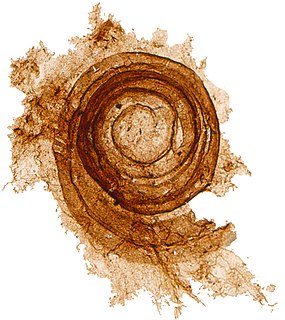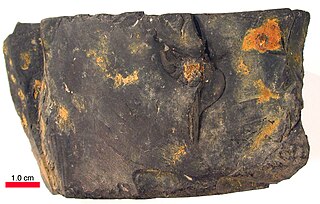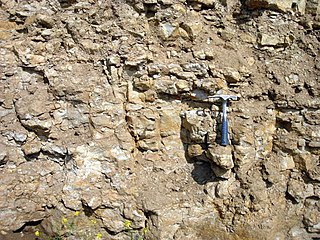Related Research Articles

In geology and mineralogy, a mineral or mineral species is, broadly speaking, a solid chemical compound with a fairly well-defined chemical composition and a specific crystal structure that occurs naturally in pure form.

Shale is a fine-grained, clastic sedimentary rock formed from mud that is a mix of flakes of clay minerals and tiny fragments of other minerals, especially quartz and calcite. Shale is characterized by its tendency to split into thin layers (laminae) less than one centimeter in thickness. This property is called fissility. Shale is the most common sedimentary rock.

Sedimentary rocks are types of rock that are formed by the accumulation or deposition of mineral or organic particles at Earth's surface, followed by cementation. Sedimentation is the collective name for processes that cause these particles to settle in place. The particles that form a sedimentary rock are called sediment, and may be composed of geological detritus (minerals) or biological detritus. The geological detritus originated from weathering and erosion of existing rocks, or from the solidification of molten lava blobs erupted by volcanoes. The geological detritus is transported to the place of deposition by water, wind, ice or mass movement, which are called agents of denudation. Biological detritus was formed by bodies and parts of dead aquatic organisms, as well as their fecal mass, suspended in water and slowly piling up on the floor of water bodies. Sedimentation may also occur as dissolved minerals precipitate from water solution.

Bituminous coal, or black coal, is a type of coal containing a tar-like substance called bitumen or asphalt. Its coloration can be black or sometimes dark brown; often there are well-defined bands of bright and dull material within the seams. It is typically hard but friable. Its quality is ranked higher than lignite and sub-bituminous coal, but poorer than anthracite. It is the most abundant rank of coal, with deposits found around the world, often in rocks of Carboniferous age. Bituminous coal is formed from sub-bituminous coal that is buried deeply enough to be heated to 85 °C (185 °F) or higher.

Diagenesis is the process that describes physical and chemical changes in sediments first caused by water-rock interactions, microbial activity, and compaction after their deposition. Increased pressure and temperature only start to play a role as sediments become buried much deeper in the Earth's crust. In the early stages, the transformation of poorly consolidated sediments into sedimentary rock (lithification) is simply accompanied by a reduction in porosity and water expulsion, while their main mineralogical assemblages remain unaltered. As the rock is carried deeper by further deposition above, its organic content is progressively transformed into kerogens and bitumens. The process of diagenesis excludes surface alteration (weathering) and deep metamorphism. There is no sharp boundary between diagenesis and metamorphism, but the latter occurs at higher temperatures and pressures. Hydrothermal solutions, meteoric groundwater, rock porosity, permeability, dissolution/precipitation reactions, and time are all influential factors.
Sedimentology encompasses the study of modern sediments such as sand, silt, and clay, and the processes that result in their formation, transport, deposition and diagenesis. Sedimentologists apply their understanding of modern processes to interpret geologic history through observations of sedimentary rocks and sedimentary structures.
Kerogen is solid, insoluble organic matter in sedimentary rocks. Comprising an estimated 1016 tons of carbon, it is the most abundant source of organic compounds on earth, exceeding the total organic content of living matter 10,000-fold. It is insoluble in normal organic solvents and it does not have a specific chemical formula. Upon heating, kerogen converts in part to liquid and gaseous hydrocarbons. Petroleum and natural gas form from kerogen. Kerogen may be classified by its origin: lacustrine (e.g., algal), marine (e.g., planktonic), and terrestrial (e.g., pollen and spores). The name "kerogen" was introduced by the Scottish organic chemist Alexander Crum Brown in 1906, derived from the Greek for "wax birth" (Greek: κηρός "wax" and -gen, γένεση "birth").
Vitrinite is one of the primary components of coals and most sedimentary kerogens. Vitrinite is a type of maceral, where "macerals" are organic components of coal analogous to the "minerals" of rocks. Vitrinite has a shiny appearance resembling glass (vitreous). It is derived from the cell-wall material or woody tissue of the plants from which coal was formed. Chemically, it is composed of polymers, cellulose and lignin.

A rock is any naturally occurring solid mass or aggregate of minerals or mineraloid matter. It is categorized by the minerals included, its chemical composition and the way in which it is formed. Rocks form the Earth's outer solid layer, the crust, and most of its interior, except for the liquid outer core and pockets of magma in the asthenosphere.

Palynology is literally the "study of dust" or of "particles that are strewn". A classic palynologist analyses particulate samples collected from the air, from water, or from deposits including sediments of any age. The condition and identification of those particles, organic and inorganic, give the palynologist clues to the life, environment, and energetic conditions that produced them.
A maceral is a component, organic in origin, of coal or oil shale. The term 'maceral' in reference to coal is analogous to the use of the term 'mineral' in reference to igneous or metamorphic rocks. Examples of macerals are inertinite, vitrinite, and liptinite.
Organic geochemistry is the study of the impacts and processes that organisms have had on the Earth. It is mainly concerned with the composition and mode of origin of organic matter in rocks and in bodies of water. The study of organic geochemistry is traced to the work of Alfred E. Treibs, "the father of organic geochemistry." Treibs first isolated metalloporphyrins from petroleum. This discovery established the biological origin of petroleum, which was previously poorly understood. Metalloporphyrins in general are highly stable organic compounds, and the detailed structures of the extracted derivatives made clear that they originated from chlorophyll.

Greensand or green sand is a sand or sandstone which has a greenish color. This term is specifically applied to shallow marine sediment that contains noticeable quantities of rounded greenish grains. These grains are called glauconies and consist of a mixture of mixed-layer clay minerals, such as smectite and glauconite mica. Greensand is also loosely applied to any glauconitic sediment.

A microfossil is a fossil that is generally between 0.001 mm and 1 mm in size, the visual study of which requires the use of light or electron microscopy. A fossil which can be studied with the naked eye or low-powered magnification, such as a hand lens, is referred to as a macrofossil.

Cannel coal or candle coal is a type of bituminous coal, also classified as terrestrial type oil shale. Due to its physical morphology and low mineral content cannel coal is considered to be coal but by its texture and composition of the organic matter it is considered to be oil shale. Although historically the term cannel coal has been used interchangeably with boghead coal, a more recent classification system restricts cannel coal to terrestrial origin, and boghead coal to lacustrine environments.

Clastic rocks are composed of fragments, or clasts, of pre-existing minerals and rock. A clast is a fragment of geological detritus, chunks and smaller grains of rock broken off other rocks by physical weathering. Geologists use the term clastic with reference to sedimentary rocks as well as to particles in sediment transport whether in suspension or as bed load, and in sediment deposits.

Oil shale geology is a branch of geologic sciences which studies the formation and composition of oil shales–fine-grained sedimentary rocks containing significant amounts of kerogen, and belonging to the group of sapropel fuels. Oil shale formation takes place in a number of depositional settings and has considerable compositional variation. Oil shales can be classified by their composition or by their depositional environment. Much of the organic matter in oil shales is of algal origin, but may also include remains of vascular land plants. Three major type of organic matter (macerals) in oil shale are telalginite, lamalginite, and bituminite. Some oil shale deposits also contain metals which include vanadium, zinc, copper, and uranium.
This glossary of geology is a list of definitions of terms and concepts relevant to geology, its sub-disciplines, and related fields. For other terms related to the Earth sciences, see Glossary of geography terms.
Bituminite is an autochthonous maceral that is a part of the liptinite group in lignite, that occurs in petroleum source rocks originating from organic matter such as algae which has undergone alteration or degradation from natural processes such as burial. It occurs as fine-grained groundmass, laminae or elongated structures that appear as veinlets within horizontal sections of lignite and bituminous coals, and also occurs in sedimentary rocks. Its occurrence in sedimentary rocks is typically found surrounding alginite, and parallel along bedding planes. Bituminite is not considered to be bitumen because its properties are different from most bitumens. It is described to have no definite shape or form when present in bedding and can be identified using different kinds of visible and fluorescent lights. There are three types of bituminite: type I, type II and type III, of which type I is the most common. The presence of bituminite in oil shales, other oil source rocks and some coals plays an important factor when determining potential petroleum-source rocks.

Funginite is a maceral, a component, organic in origin, of coal or oil shale, that exhibits several different physical properties and characteristics under particular conditions, and its dimensions are based upon its source and place of discovery. Furthermore, it is primarily part of a group of macerals that naturally occur in rocks containing mostly carbon constituents, specifically coal. Due to its nature, research into the chemical structure and formula of funginite is considered limited and lacking. According to Chen et al. referencing ICCP, 2001, alongside the maceral secretinite, they "are both macerals of the inertinite group, which is more commonly known as fossilized charcoal, and were previously jointly classified as the maceral sclerotinite". In the scientific community, the discernment between the two does not remain entirely clear, but there are slight particular and specific differences in regards to the composition between both. It is also the product of fungal development on these carbon rich sedimentary rocks.
References
- ↑ Pickel, W.; Kus, J.; Flores, D.; Kalaitzidis, S.; Christanis, K.; Cardott, B.J. (2017). "Classification of liptinite – ICCP System 1994". International Journal of Coal Geology. 169: 40–61. doi: 10.1016/j.coal.2016.11.004 .
- ↑ Taylor et al., 1998. Organic Petrography. Gebrüder Borntraeger, Berlin. pp. 176
- ↑ Stopes, M.C. (1935). "On the petrology of banded bituminous coal". Fuel in Science and Practice. 14: 4–13.